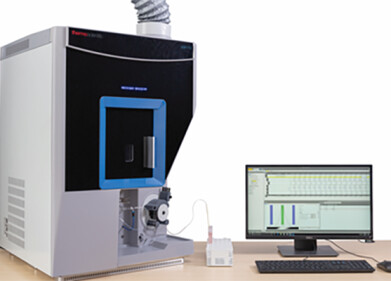Mass Spectrometry & Spectroscopy
Proteomics - Top-Down vs Bottom-Up
Sep 13 2021
From classifying poisonous mushrooms and improving agricultural crop yields to developing vaccines and diagnosing disease, proteomics has a myriad of applications. Scientists rely on two different approaches to analyse the proteomes of living organisms, cells, tissues and systems – top-down and bottom-up. Both rely on mass spectrometry (MS) to identify and characterise proteins.
Each strategy has its own unique pros and cons, which we explore in more detail below.
Bottom-up proteomics
The bottom-up approach uses proteolytic cleavage to break down purified proteins and complex protein mixtures. The peptides produced during proteolytic cleavage are then analysed using a mass spectrometer. Techniques such as gel electrophoresis (GE) and chromatography may be used prior to bottom-up proteomics to separate individual proteins.
Two different approaches are used to identify proteins in bottom-up proteomics - peptide mass fingerprinting and tandem MS (MS–MS).
- Peptide mass fingerprinting
Peptide mass fingerprinting is a high throughput technique that uses MS to analyse and identify proteins. First, the protein in question is broken down into peptides. A mass spectrometer is used to measure the absolute masses of the peptides, with results then compared to other protein sequences using a computer database.
While useful, there are some disadvantages to peptide mass fingerprinting. These include the need for pure proteins or relatively simple mixtures. Peptide mass fingerprinting also relies on the identification of multiple peptides before a protein can be characterised.
- Tandem MS
Tandem MS uses a mass analyser to isolate a peptide ion and divide it into smaller fragments. The masses of these individual fragment ions are then used to determine the amino acid sequence of the original peptide ion. Unlike peptide mass fingerprinting, tandem MS is not a high throughput technique and can be extremely labour intensive.
Top-down proteomics
Top-down proteomics uses MS analysis to identify proteins using complete protein ions or fragments. Techniques such as liquid chromatography and 2D gel electrophoresis are used to separate these intact ions or fragments from complex biological samples before being introduced to a mass spectrometer.
One of the main benefits of top-down proteomics is the use of intact proteins. Samples don’t need to be cleaved, which preserves the structural characteristics of the protein which are often compromised when using a bottom-up approach. Eliminating the need to cleave proteins before MS analysis also improves efficiency and makes top-down proteomics a faster solution.
Want to know more about the latest advances in top-down and bottom-up proteomics? Don’t miss insight from Gary Kruppa on behalf of Bruker Daltonics in ‘dia-PASEF: A Result of the Co-evolution of Mass Spectrometry and Proteomics’.
Digital Edition
Lab Asia 31.2 April 2024
April 2024
In This Edition Chromatography Articles - Approaches to troubleshooting an SPE method for the analysis of oligonucleotides (pt i) - High-precision liquid flow processes demand full fluidic c...
View all digital editions
Events
May 05 2024 Seville, Spain
InformEx Zone at CPhl North America
May 07 2024 Pennsylvania, PA, USA
May 14 2024 Oklahoma City, OK, USA
May 15 2024 Birmingham, UK
May 21 2024 Lagos, Nigeria










.jpg)







